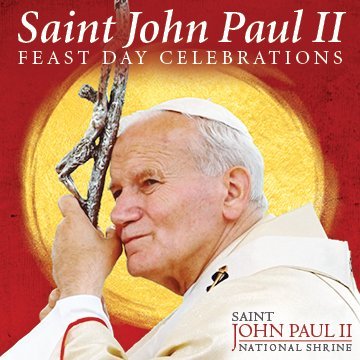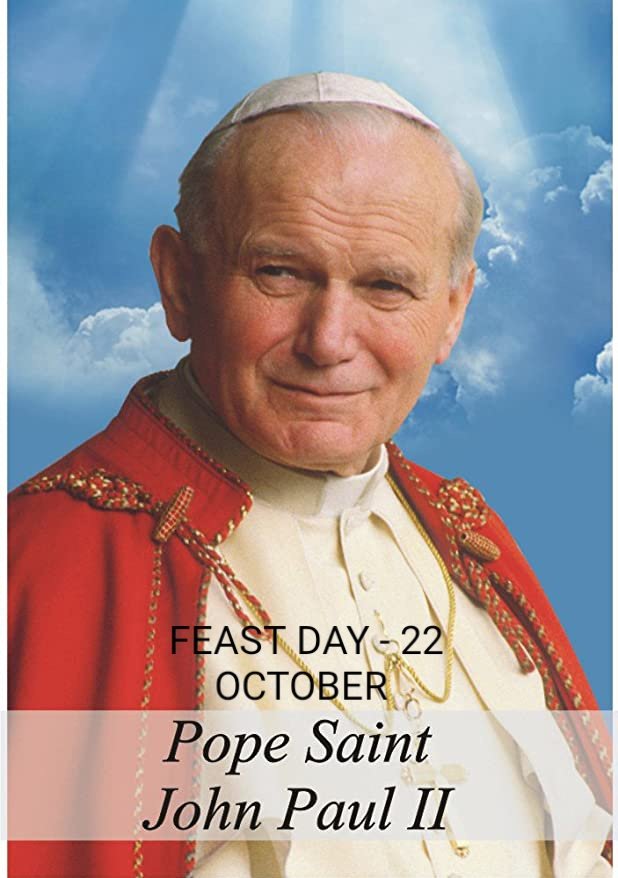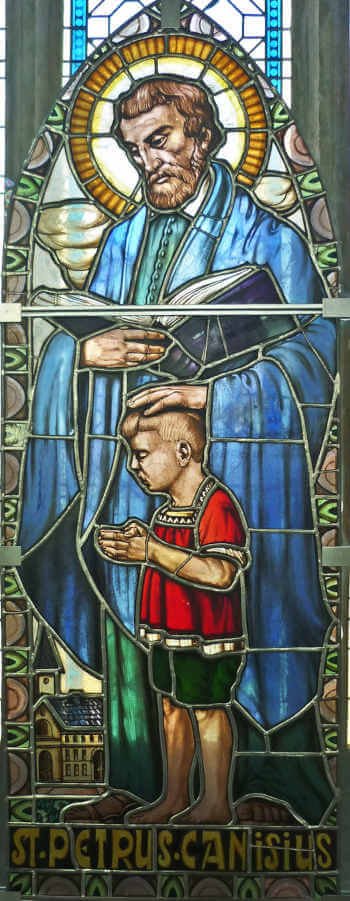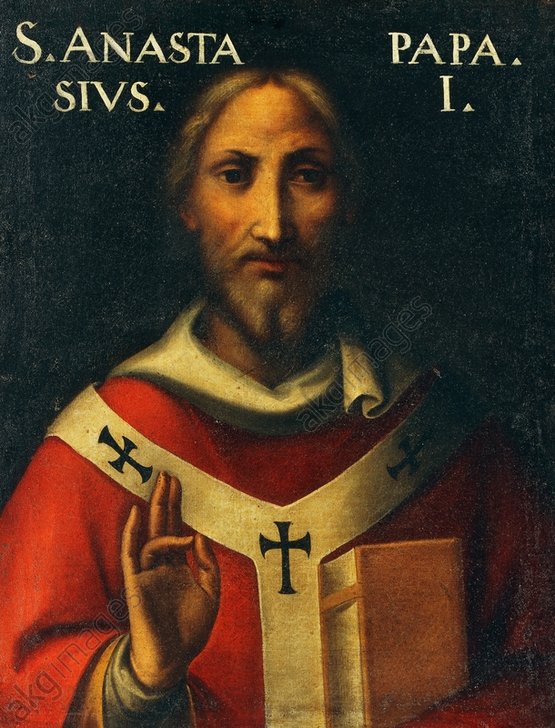
Psalm 23:6
October 21, 2021
Deuteronomy 10:12
October 22, 2021FEAST OF SAINT JOHN PAUL II, POPE
FEAST DAY – 22nd OCTOBER
Karol Wojtyła – “Lolek” to his familykm and friends – learned a great deal from suffering. Born in 1920 in Wadowice, Poland, his mother died when he was just nine. At twelve, his elder brother died. He applied to a university in Krakow at the age of nineteen to study Polish literature, but a year later Germany invaded Poland, the university was closed, and the professors sent to concentration camps. During German occupation, Karol, aspiring to become an actor, staged secret theater acts with his friends, met many manual laborers, and learned the hardness of their lives as well as their great dignity, becoming a laborer in a stone quarry and a chemical plant.
His father, was deeply prayerful, and taught him how to invoke the Holy Spirit. A friend, the tailor Jan Tyranowski, showed Karol the beauty of the interior life. Karol’s father died in 1941, leaving the young man alone in the world. But with this new grief came illumination, as he received God’s calling to be a priest. lHe studied for the priesthood in Krakow’s clandestine seminary and was ordained in 1946. His bishop, becoming aware of the young priest’s intellectual and spiritual gifts, sent him to complete a doctorate in Rome.
Later, as pastor of a parish and a university chaplain, Fr. Wojtyła became a professor of moral theology and ethics at Krakow and Lublin, where a group of students often accompanied him on hikes in the mountains. Far from the prying ears of Poland’s communist regime, the young people discussed philosophy, theology, the Christian life, and often, their marriages, with Fr. Wojtyła on their outings. They would become the living basis for his theology of the body, or theology of human love.
On one of these outings, in 1958, Wojtyła received news that he would become a bishop. The communist authorities had approved his appointment, believing that a philosopher and poet would not cause them much trouble. But this young bishop was a powerful preacher who began annually celebrating Christmas midnight Mass in a field for the inhabitants of Nowa Huta, a worker’s neighborhood that authorities had deliberately built without a church.
Soon great events were taking place in the Church: a new ecumenical Council, convoked by Pope John XXIII to help the Church to carry out her mission in the modern world. From 1962 – 1965 Bishop Wojtyła participated extensively in Vatican Council II, contributing to the drafting of the Pastoral Constitution Gaudium et spes and to the document on religious freedom, Dignitatis humanae. In 1967 he became a Cardinal.
In 1978, Albino Luciani was elected Pope John Paul I, but died a month later. The shocked Cardinals entered a conclave to elect a pope for the second time in a year. Thousands of people’s attention was riveted on St. Peter’s when the new pope’s name was announced, then they turned to one another in confusion as they realized that for the first time in 455 years, a non-Italian had become Pope.
He had been prepared for his task through his own suffering and the suffering of his people. On October 22, 1978, at the inaugural Mass of his pontificate, Pope John Paul II cried out to the whole world not to be afraid, but to open wide the doors to Christ, in whom alone a human being understands himself, to Christ, the Redeemer of Man. This Pope would go far, traveling some 1,100,000 kilometers around the world to show people the love of this Christ, and to invite them to let go of fear.
On May 13, 1981, the feast of Our Lady of Fatima, the Pope would find a different way to show the world what it means to face fear, armed only with the love of God, the power of forgiveness, and the protection of the Mother of God. During that day’s papal audience, an assassin aimed and fired. St. Peter’s Square erupted into panic as the Pope fell. He came close to death, saying later that the Mother of God, to whom he had entrusted his pontificate, had protected him on her feast day. He made a pilgrimage to Fatima to place the bullet in her crown. He made another pilgrimage, to prison, to forgive the “brother who shot me” face-to-face.
John Paul II was a tireless defender of human dignity, a prolific author and a tireless preacher, convinced that the human person is “the way of the Church” and that the splendor of truth shines forth in a special way, in man, created in the image and likeness of God (Veritatis Splendor 1). The Pope experiencing two forms of totalitarianism firsthand, was outspoken whenever he encountered any ideology that threatened the dignity of the human person, from dictatorships to Marxism to unbridled capitalism. The Solidarity movement in his own country drew strength from his example, which helped precipitate the fall of communism throughout Eastern Europe.
From the beginning of his pontificate, John Paul II sought to heal divisions between the Christian churches, especially with his Orthodox brethren. He was convinced that division was contrary to the will of the Lord and weakened Christian witnesses. As a defender of human dignity and shepherd of the People of God, John Paul II was conscious of his task of leading the Church and the world to a celebration of the 2,000th anniversary of the birth of Jesus Christ and, into the new millennium.
The Great Jubilee of the year 2000 was a privileged moment when believers praised the Holy Trinity for the Redeemer who became their companion on life’s path towards the new heaven and the new earth. In the 1990s, John Paul II was diagnosed with Parkinson’s disease. So began the final chapter of his pontificate and mission, in which the energetic preacher who had traveled the world had one more “homily” to give, not with words but, as he gradually lost the capacity to speak, with silence.
As his successor Pope Benedict XVI observed, this “master of words” still had, not to say, but to show that “the Lord redeemed us with his cross, with the passion, as an extreme act of love.” In the last years of John Paul II’s pontificate, he consoled the sick with his sickness; in the last months – including a mute blessing given to the crowds from his window – he showed what it meant to live the realities of suffering and death in Christ, as part of his Body.
On April 2, 2005, the vigil of the feast of Divine Mercy, John Paul II died. His last words were whispered, “Let me go to my Father’s house”. Some 3 million people came to Rome for his funeral, and millions more followed it on television. They had heard when this Pope had told them not to be afraid, and they understood that in those last years and months, he had told them this in the most profound way possible. In 2011, Pope Benedict XVI beatified his predecessor, and in 2013, Pope Francis declared him a saint.
PRAYER TO SAINT JOHN PAUL II
Oh, St. John Paul, from the window of heaven, grant us your blessing! Bless the church that you loved and served and guided, courageously leading it along the paths of the world in order to bring Jesus to everyone and everyone to Jesus. Bless the young, who were your great passion. Help them dream again, help them look up high again to find the light that illuminates the paths of life here on earth.
Bless each family. You warned of Satan’s assault against this precious and indispensable divine spark that God lit on earth. St. John Paul, with your prayer, may you protect the family and every life that blossoms from the family.
Pray for the whole world, which is still marked by tensions, wars and injustice.
You tackled war by invoking dialogue and planting the seeds of love: pray for us so that we may be tireless sowers of peace. Oh St. John Paul, from heaven’s window, where we see you next to Mary, send God’s blessing down upon us all. Amen.






2 Prayers
Amen to the above inspiring story and prayer to Pope St John Paul II.
St. JOHN PAUL II please pray for us All to have the courage and strength to carry on with our lives, in these trying times. In Jesus’ Name we pray, Amen ?❤️✝️
Amen… In the Name of Jesus our Lord ?❤